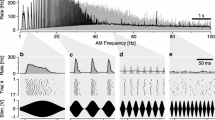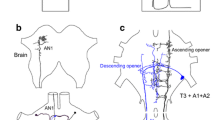Abstract
In behavioral experiments with a Y labyrinth it was shown that phonotaxis in the female crickets in respect to the calling signals (CS) of the males depends on the spectrum of the signal. The necessary and sufficient condition for development of normal phonotaxis is the preservation of the first, low-frequency (LF) component of the spectrum (5 kHz). Signals with a time pattern identical to that of a CS but with a spectrum containing only the high-frequency (HF) component (12.5 kHz) do not evoke positive phonotaxis. HF signals in the frequency-range 10–40 kHz evoke negative phonotaxis in females under conditions of “tethered flight.” In the auditory system of the crickets, beginning with the tympanal organ, there is a clear separation of the elements effecting LF and HF signals. Two types of ascending interneurons transmitting acoustic information from the primary auditory center to the brain are described in detail. The first is connected primarily with LF receptors and transmits clearly all the time-dependent characteristics of the CS most important for recognition. The second apparently participates in the production of negative phonotaxis. It is connected primarily with HF receptors, has considerable after-effect and also raises sensitivity to sounds of low intensity, emphasizes the initial moment in the effect of a stimulus, and “habituates” rapidly to repeated stimulations.
Similar content being viewed by others
Literature cited
I. Regen, Pflügers Arch.,155, 193 (1913).
T. J. Walker, Ann. Entomol. Soc. Amer.,50, 626 (1957).
K. G. Hill, J. J. Loftus-Hills, and D. F. Gartside, Austr. J. Zool.,20, 153 (1972).
M. D. Zaretsky, J. Comp. Physiol.,79, 153 (1972).
V. F. Shuvalov and A. V. Popov, Zh. Tvol. Biokhim. Fiziol.,9, 177 (1973).
V. F. Shuvalov and A. V. Popov, Zool. Zh.,52, 1179 (1973).
K. G. Hill, J. Comp. Physiol.,93, 7 (1974).
B. Dumortier, in: Acoustic Behavior of Animals, R. G. Busnel (ed.), Elsevier, Amsterdam (1963), p. 583.
V. F. Shuvalov and A. V. Popov, Zh. Évol. Biokhim. Fiziol.,7, 612 (1971).
A. V. Popov, Zh. Evol. Biokhim. Fiziol.,9, 265 (1973).
A. V. Popov, V. F. Shuvalov, A. N. Knyazev, and N. A. Klar-Spasovskaya, Entomol. Obozr.,53, 258 (1974).
A. V. Popov, Tr. Vsesoyuzn. Éntomol. Obshch.,53, 182 (1969).
R. D. Zhantiev and V. S. Chukanov, Vestn. MGU, No. 2, 3 (1972).
C. Herbig, Arch. Mikr. Anat. Entwickl.,61, 697 (1903).
D. Young and E. Ball, Z. Zeilforsch.,147, 293 (1974).
Author information
Authors and Affiliations
Additional information
Translated from Zhurnal Évolyutsionnoi Biokhimii i Fiziologii, Vol. 11, No. 5, pp. 453–460, September–October, 1975.
Rights and permissions
About this article
Cite this article
Popov, A.V., Shuvalov, V.F. & Markovich, A.M. The spectrum of the calling signals, phonotaxis, and the auditory system in the cricket Gryllus bimaculatus. Neurosci Behav Physiol 7, 56–62 (1976). https://doi.org/10.1007/BF01148749
Received:
Issue Date:
DOI: https://doi.org/10.1007/BF01148749




